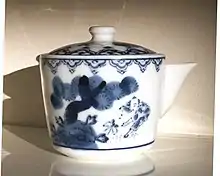
Hirado ware brush rest depicting three karako Chinese boys in the process of rolling a snowball

Karako (唐子) is a Japanese term used in art with the depiction of Chinese children playing. The literal translation means "Tang children". The children tend to be depicted with a particular hairstyle that is knotted at the top and shaved on both sides of the head.[1][2]
The theme of these playing children can be found in screens and ceramics and other forms of Japanese art. They symbolise the innocence and joy of childhood.[1] Arita ware, Nabeshima ware, and Hirado ware are typical examples of Japanese pottery that depict karako. In painted form on ceramic ware, it often shows boys chasing butterflies.[3]
See also
References
- 1 2 "Karako (Chinese Children) Playing Games - Erik Thomsen Asian Art". www.erikthomsen.com.
- ↑ Yorke, Nick. "The Kimono Gallery". www.thekimonogallery.com.
- ↑ "『『お茶の子さいさい』は『一文惜しみの百知らず』❓❗編』". ameblo.jp.
External links
![]() Media related to Karako at Wikimedia Commons
Media related to Karako at Wikimedia Commons
This article is issued from Wikipedia. The text is licensed under Creative Commons - Attribution - Sharealike. Additional terms may apply for the media files.